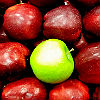
Session Overview
 |
Do you ever get distracted when you are supposed to be focused? Why do we pay attention to something? How are we able to pay attention to certain things while ignoring others? Attention is present in almost all domains of human thought and feeling. During this session, we will focus on visual attention and explore how certain things can captivate our attention. Keywords: attention, Stroop effect, hypnosis, top-down, bottom-up, attentional blink, multiple object tracking, subliminal perception, cocktail party effect Image by miamism on Flickr. |
Session Activities
Readings
Read the following before watching the lecture video.
- One of the following textbook selections:
Lecture Videos
View Full Video
- Lecture 7: Attention (00:42:20)
View by Chapter
- What Do We Mean by "Attention"? (00:02:51)
- Demonstrations of the Limits of Attention (00:11:02)
Demonstrations of the Limits of Attention
> Download from iTunes U (MP4 - 91MB)
> Download from Internet Archive (MP4 - 91MB)
- Hypnosis and the Stroop Effect (00:04:08)
- Visual Search and Attentional Blink (00:09:16)
Visual Search and Attentional Blink
> Download from iTunes U (MP4 - 91MB)
> Download from Internet Archive (MP4 - 91MB)
- Object Tracking and Improving Attention (00:07:20)
Object Tracking and Improving Attention
> Download from iTunes U (MP4 - 91MB)
> Download from Internet Archive (MP4 - 91MB)
- Subliminal Perception (00:07:02)
Video Resources
Discussion: Attention
Today we're also going to talk about attention. How we engage with the world, but only a small part of it at a time. Why we can't engage with the whole thing, and what it would be like to engage with the whole thing. Limits on our attention: why we can't perceive everything at once.... Read more »
Check Yourself
Describe an example of selective attention. Does selective attention completely block out all other sensory input? If not give an example. What are the advantages and disadvantages of processes involved in selective attention?
› Sample Answer
Further Study
These optional resources are provided for students that wish to explore this topic more fully.
| TYPE | CONTENT | CONTEXT |
|---|---|---|
| Additional reading | Cherry, E. "Some Experiments on the Recognition of Speech, with One and with Two Ears." The Journal of the Acoustical Society of America 25, no. 5 (1953). ( PDF - 1.4MB) PDF - 1.4MB) |
E. Colin Cherry's original 1953 selective attention experiment. The study describes an experiment involving dichotic listening, a demonstration of which was performed during lecture but removed for privacy reasons. |
| Textbook supplement | Study materials for Ch. 4, "Sensation and Perception: How the World Enters the Mind." In Kosslyn & Rosenberg, Psychology in Context, 3/e (Pearson, 2007) | Practice test questions, flashcards, and media for a related textbook |
